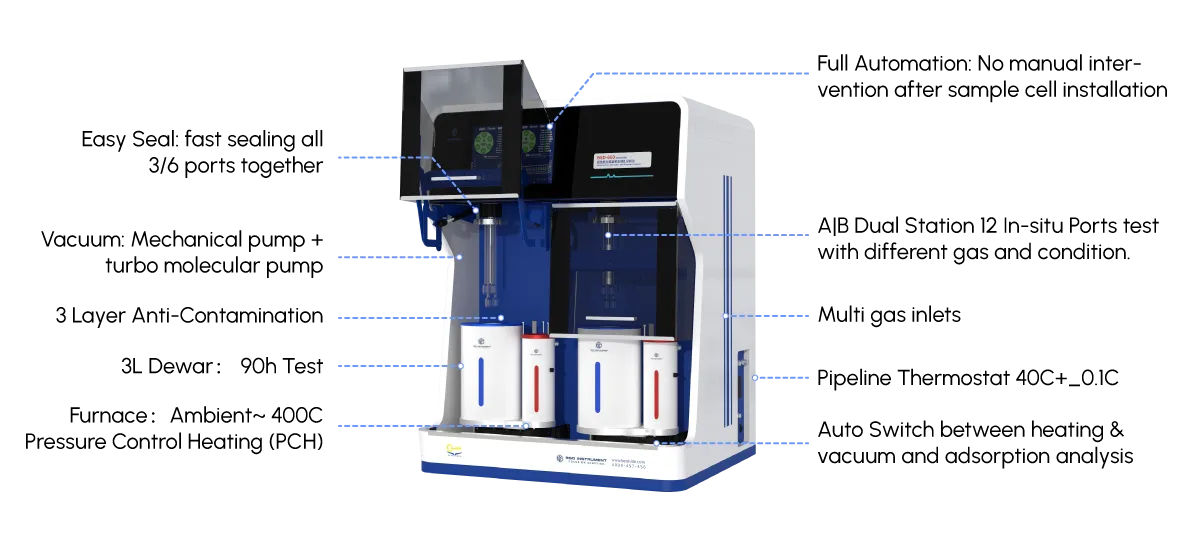Home / Blog / Gas Adsorption Analyzer Technologies: Advancements and Future Trends
Gas Adsorption Analyzer Technologies: Advancements and Future Trends
25 10 月, 2025From: BSD Instrument


I. Current Key Technologies in Gas Adsorption Analysis
1. Static Volumetric Method
Principle: Measures the volume of gas adsorbed onto a sample at a constant temperature (usually liquid nitrogen temperature, 77 K) by detecting pressure changes in a closed system. Strengths: High accuracy for surface area and micropore analysis; widely accepted and standardized. Limitations: Slower analysis time; requires precise pressure sensors and vacuum systems.
2. Dynamic (Flow) Method
Principle: Measures adsorption in a continuous gas flow system, often using a carrier gas (e.g., helium or nitrogen) and an adsorptive gas (e.g., nitrogen or argon). Strengths: Faster analysis; suitable for quality control and routine measurements. Limitations: Less accurate for detailed pore structure characterization compared to static methods.
3. Multi-Gas and Multi-Component Adsorption
Recent systems allow analysis using different adsorptives (e.g., N₂, Ar, CO₂, H₂, CH₄) to gain insights into material behavior under varying conditions or for specific applications (e.g., CO₂ capture, hydrogen storage). Enables temperature-variable studies (e.g., using cryogenic fluids other than liquid nitrogen).
4. Advanced Data Analysis Models
Utilization of sophisticated theoretical models such as: Density Functional Theory (DFT): More accurate pore size distribution, especially for micropores and mesopores. Horvath-Kawazoe (HK): Primarily for micropore analysis. Quantachrome’s ASAP or Micromeritics’ Tristar/BET series, which integrate advanced software for data interpretation.
II. Technological Advancements
1. High-Throughput and Automation
Modern analyzers support automated sample preparation, degassing, and sequential analysis of multiple samples with minimal user intervention. Integration with robotic arms and sample changers enhances throughput in industrial and research labs.
2. Improved Pressure and Temperature Control
High-precision pressure transducers (down to sub-Pa ranges) and advanced vacuum systems enable accurate detection of very low adsorption quantities. Enhanced temperature regulation ensures consistency, especially for experiments requiring cryogenic conditions.
3. Expanded Analytical Range
Ability to measure ultra-high surface areas (> 10,000 m²/g) and characterize nano-scale pores (< 1 nm) with greater reliability. Some systems now offer analysis at elevated temperatures (e.g., for studying materials under operational conditions).
4. Integration with Other Techniques
Coupling gas adsorption analyzers with techniques like Mercury Intrusion Porosimetry (MIP), X-ray Diffraction (XRD), or Scanning Electron Microscopy (SEM) provides comprehensive material characterization. Hybrid systems or data fusion approaches are emerging for multidimensional material analysis.
5. Green and Sustainable Practices
Efforts to reduce helium consumption (a limited resource) by using alternative carrier gases or improving system efficiency. Energy-efficient vacuum pumps and sustainable cooling methods are being explored.
III. Emerging and Future Trends
1. In-Situ and Operando Adsorption Analysis
In-situ adsorption measurements under real reaction conditions (e.g., during catalysis or gas separation) are gaining interest. Operando techniques combine adsorption analysis with spectroscopic or diffraction tools to monitor dynamic changes in material properties during gas interactions.
2. Microfluidics and Miniaturization
Development of compact, portable gas adsorption devices for field applications, quality control, or point-of-use material screening. Microfluidic platforms may enable rapid, low-sample-volume adsorption measurements.
3. Machine Learning and AI in Data Analysis
AI algorithms are being explored to enhance data interpretation, model selection, and prediction of material performance based on adsorption isotherms. Smart software can auto-detect anomalies, suggest optimal analysis conditions, and accelerate R&D cycles.
4. Broader Gas Compatibility and Environmental Applications
Analysis of adsorption behavior with gases like hydrogen (H₂), methane (CH₄), carbon dioxide (CO₂), and volatile organic compounds (VOCs) for energy storage, environmental monitoring, and gas separation applications. Focus on CO₂ capture and sequestration, hydrogen economy, and air purification drives specialized analyzer development.
5. User-Friendly Interfaces and Cloud-Based Data Management
Modern systems increasingly feature intuitive graphical interfaces, touchscreen controls, and remote monitoring capabilities. Cloud integration allows secure data sharing, collaboration, and real-time analytics across global research teams.
IV. Applications Driving Innovation
Energy Storage: Hydrogen and methane adsorption for next-gen fuel cells and storage solutions. Catalysis: Understanding active sites and surface interactions. Environmental Science: CO₂ capture, air filtration, and pollution control materials. Pharmaceuticals & Healthcare: Characterization of drug carriers and porous excipients. Nanotechnology: Tailoring nanostructured materials for electronics, sensors, and separations.
V. Conclusion
Our Latest Blog & Articles
Stay updated with our latest news. Discover new product launches, innovative technologies, and upcoming events. Join our community and stay informed about all things lab equipment.
-
27 10 月, 2025
Cheap and Efficient Adsorption-Desorption Systems for Water Pollution Control in China
-
25 10 月, 2025
Gas Adsorption Analyzer Technologies: Advancements and Future Trends
-
23 10 月, 2025
Micropore and Mesopore Analysis for Improving Gas Storage and Separation Efficiency
-
20 10 月, 2025
Membrane Porosity and Its Impact on Mass Transport and Permeation Efficiency





